2016 NISSAN MURANO HYBRID engine
[x] Cancel search: enginePage 19 of 49
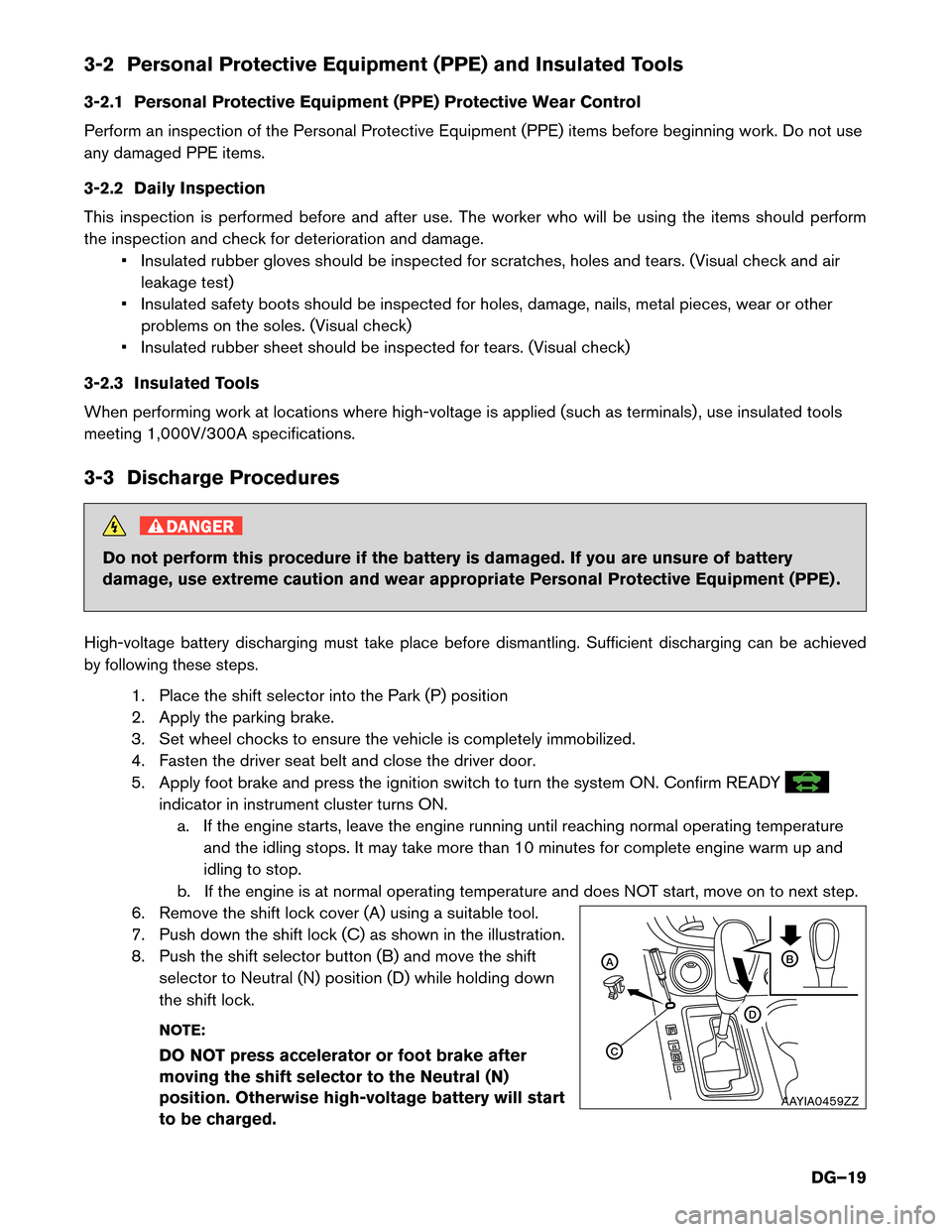
3-2 Personal Protective Equipment (PPE) and Insulated Tools
3-2.1
Personal Protective Equipment (PPE) Protective Wear Control
Perform an inspection of the Personal Protective Equipment (PPE) items before beginning work. Do not use
any damaged PPE items.
3-2.2 Daily Inspection
This inspection is performed before and after use. The worker who will be using the items should perform
the inspection and check for deterioration and damage. • Insulated rubber gloves should be inspected for scratches, holes and tears. (Visual check and airleakage test)
• Insulated safety boots should be inspected for holes, damage, nails, metal pieces, wear or other problems on the soles. (Visual check)
• Insulated rubber sheet should be inspected for tears. (Visual check)
3-2.3 Insulated Tools
When performing work at locations where high-voltage is applied (such as terminals) , use insulated tools
meeting 1,000V/300A specifications.
3-3 Discharge Procedures DANGER
Do not perform this procedure if the battery is damaged. If you are unsure of battery
damage,
use extreme caution and wear appropriate Personal Protective Equipment (PPE) .
High-voltage battery discharging must take place before dismantling. Sufficient discharging can be achieved
by following these steps.
1. Place the shift selector into the Park (P) position
2. Apply the parking brake.
3. Set wheel chocks to ensure the vehicle is completely immobilized.
4. Fasten the driver seat belt and close the driver door.
5. Apply foot brake and press the ignition switch to turn the system ON. Confirm READY indicator in instrument cluster turns ON.
a.
If the engine starts, leave the engine running until reaching normal operating temperature
and the idling stops. It may take more than 10 minutes for complete engine warm up and
idling to stop.
b. If the engine is at normal operating temperature and does NOT start, move on to next step.
6. Remove the shift lock cover (A) using a suitable tool.
7. Push down the shift lock (C) as shown in the illustration.
8. Push the shift selector button (B) and move the shift selector to Neutral (N) position (D) while holding down
the shift lock.
NOTE:
DO NOT press accelerator or foot brake after
moving the shift selector to the Neutral (N)
position. Otherwise high-voltage battery will start
to be charged. C B
D
A
AAYIA0459ZZDG–19
Page 20 of 49
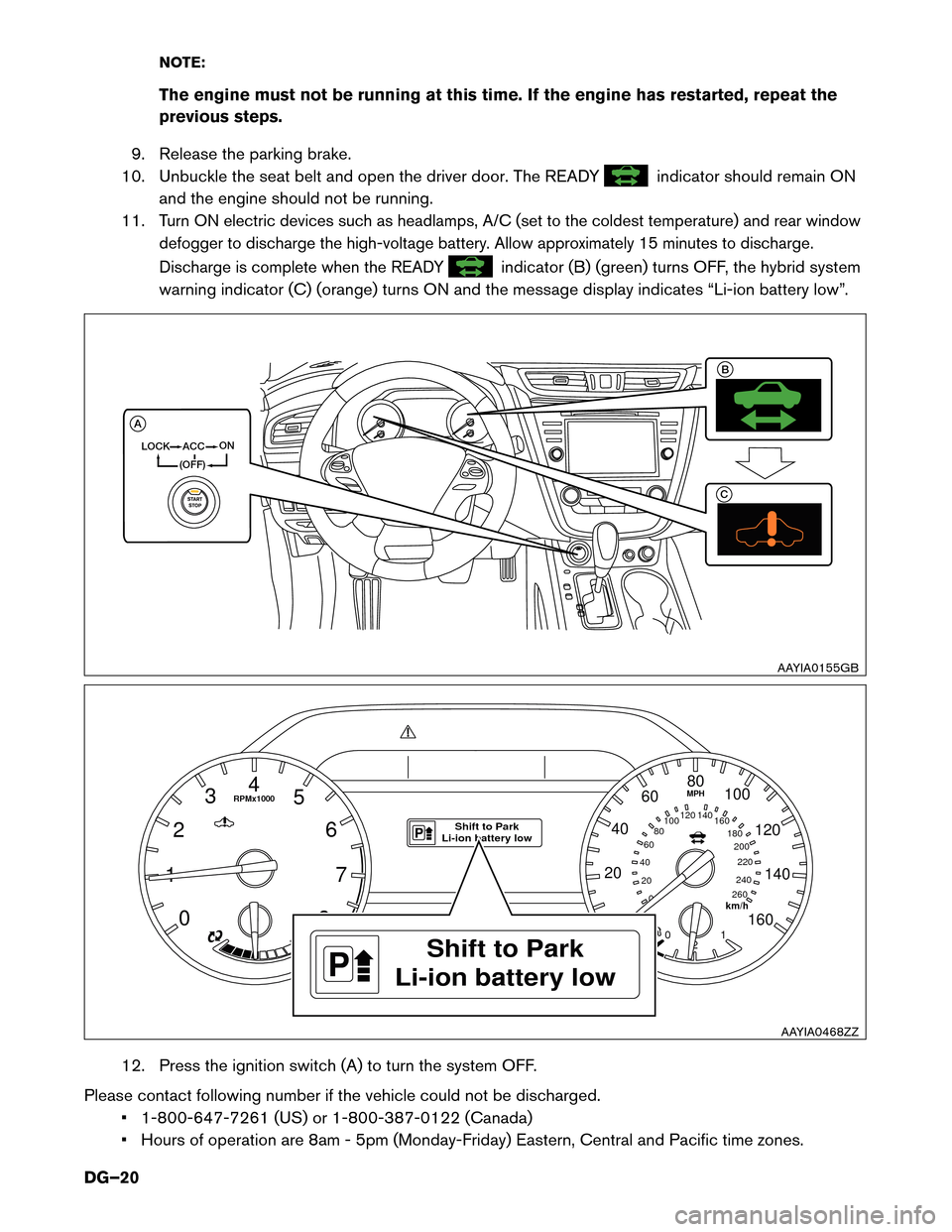
NOTE:
The
engine must not be running at this time. If the engine has restarted, repeat the
previous steps.
9. Release the parking brake.
10. Unbuckle the seat belt and open the driver door. The READY indicator should remain ON
and
the engine should not be running.
11.
Turn ON electric devices such as headlamps, A/C (set to the coldest temperature) and rear window
defogger to discharge the high-voltage battery. Allow approximately 15 minutes to discharge.
Discharge is complete when the READY indicator (B) (green) turns OFF, the hybrid system
warning
indicator (C) (orange) turns ON and the message display indicates “Li-ion battery low”.
12. Press the ignition switch (A) to turn the system OFF.
Please contact following number if the vehicle could not be discharged. • 1-800-647-7261 (US) or 1-800-387-0122 (Canada)
• Hours of operation are 8am - 5pm (Monday-Friday) Eastern, Central and Pacific time zones. B
CA
LOCK
AC
C
(OFF) ON AAYIA0155GB
1
0
2
3
4
5
6
7
8
PWR km/h
MP
H
RPMx1000 20
0 0
0
20
40
60
80
180
200
220
240
260
100
160
120 140
1
2
40
60
80
100
120
140
160
PShift to Park
Li-ion battery low
P
Shift to Park
Li-ion battery low AAYIA0468ZZ
DG–20
Page 22 of 49
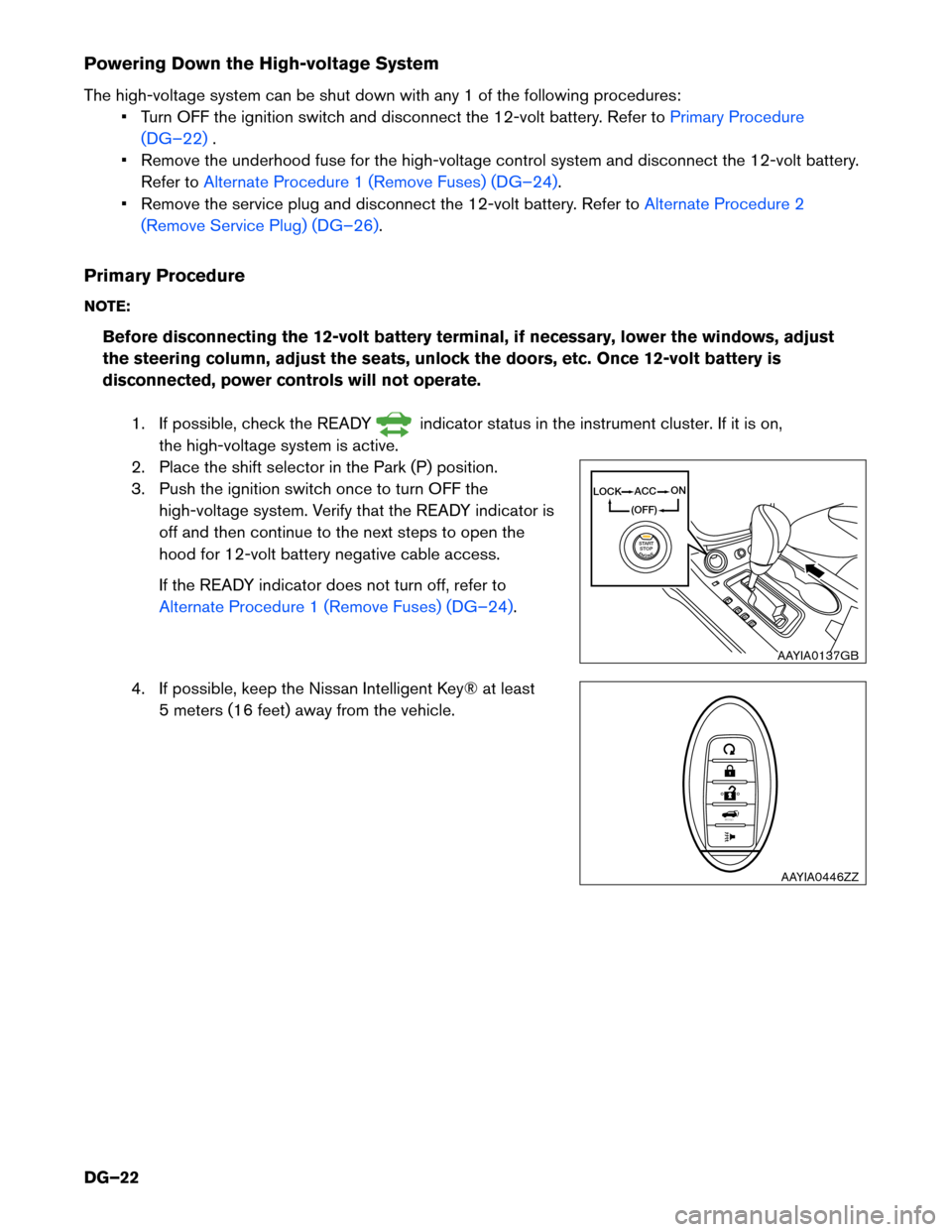
Powering Down the High-voltage System
The
high-voltage system can be shut down with any 1 of the following procedures:• Turn OFF the ignition switch and disconnect the 12-volt battery. Refer to Primary Procedure
(DG–22) .
•
Remove the underhood fuse for the high-voltage control system and disconnect the 12-volt battery.
Refer to Alternate Procedure 1 (Remove Fuses) (DG–24).
•
Remove the service plug and disconnect the 12-volt battery. Refer to Alternate Procedure 2
(Remove
Service Plug) (DG–26) .
Primary
Procedure
NOTE:
Before disconnecting the 12-volt battery terminal, if necessary, lower the windows, adjust
the steering column, adjust the seats, unlock the doors, etc. Once 12-volt battery is
disconnected, power controls will not operate.
1. If possible, check the READY indicator status in the instrument cluster. If it is on,
the
high-voltage system is active.
2. Place the shift selector in the Park (P) position.
3. Push the ignition switch once to turn OFF the high-voltage system. Verify that the READY indicator is
off and then continue to the next steps to open the
hood for 12-volt battery negative cable access.
If the READY indicator does not turn off, refer to
Alternate Procedure 1 (Remove Fuses) (DG–24).
4.
If possible, keep the Nissan Intelligent Key® at least
5 meters (16 feet) away from the vehicle.P R N
D ACC
ENGINESTART
STOP LOCK
(OFF)
ON
AAYIA0137GB
HOLD AAYIA0446ZZ
DG–22
Page 26 of 49
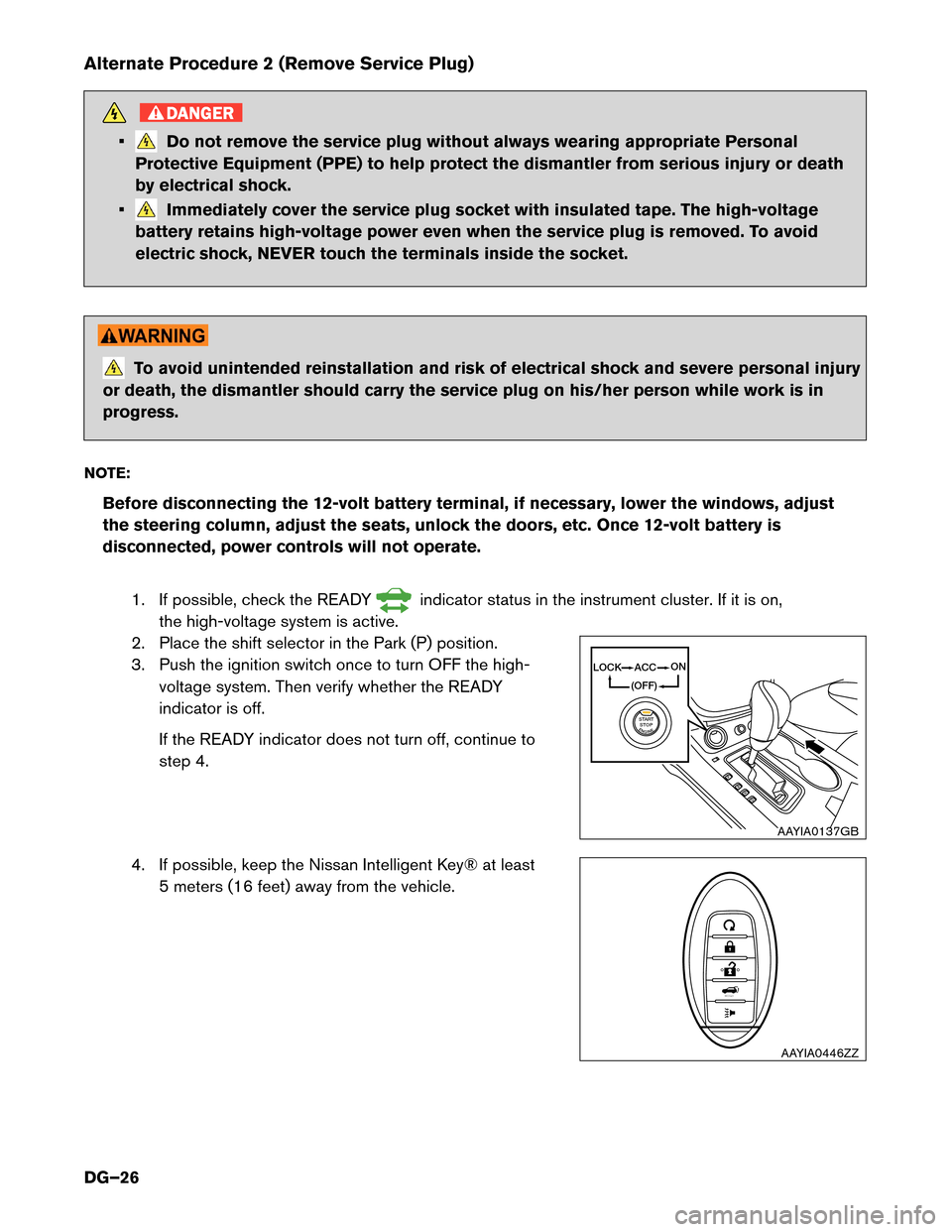
Alternate Procedure 2 (Remove Service Plug)
DANGER
• Do not remove the service plug without always wearing appropriate Personal
Protective Equipment (PPE) to help protect the dismantler from serious injury or death
by electrical shock.
• Immediately cover the service plug socket with insulated tape. The high-voltage
battery
retains high-voltage power even when the service plug is removed. To avoid
electric shock, NEVER touch the terminals inside the socket. To avoid unintended reinstallation and risk of electrical shock and severe personal injury
or
death, the dismantler should carry the service plug on his/her person while work is in
progress.
NOTE: Before disconnecting the 12-volt battery terminal, if necessary, lower the windows, adjust
the steering column, adjust the seats, unlock the doors, etc. Once 12-volt battery is
disconnected, power controls will not operate.
1. If possible, check the READY indicator status in the instrument cluster. If it is on,
the
high-voltage system is active.
2. Place the shift selector in the Park (P) position.
3. Push the ignition switch once to turn OFF the high- voltage system. Then verify whether the READY
indicator is off.
If the READY indicator does not turn off, continue to
step 4.
4. If possible, keep the Nissan Intelligent Key® at least 5 meters (16 feet) away from the vehicle.
PR N
D ACC
ENGINESTART
STOP LOCK
(OFF)
ON
AAYIA0137GB
HOLD AAYIA0446ZZ
DG–26
Page 33 of 49
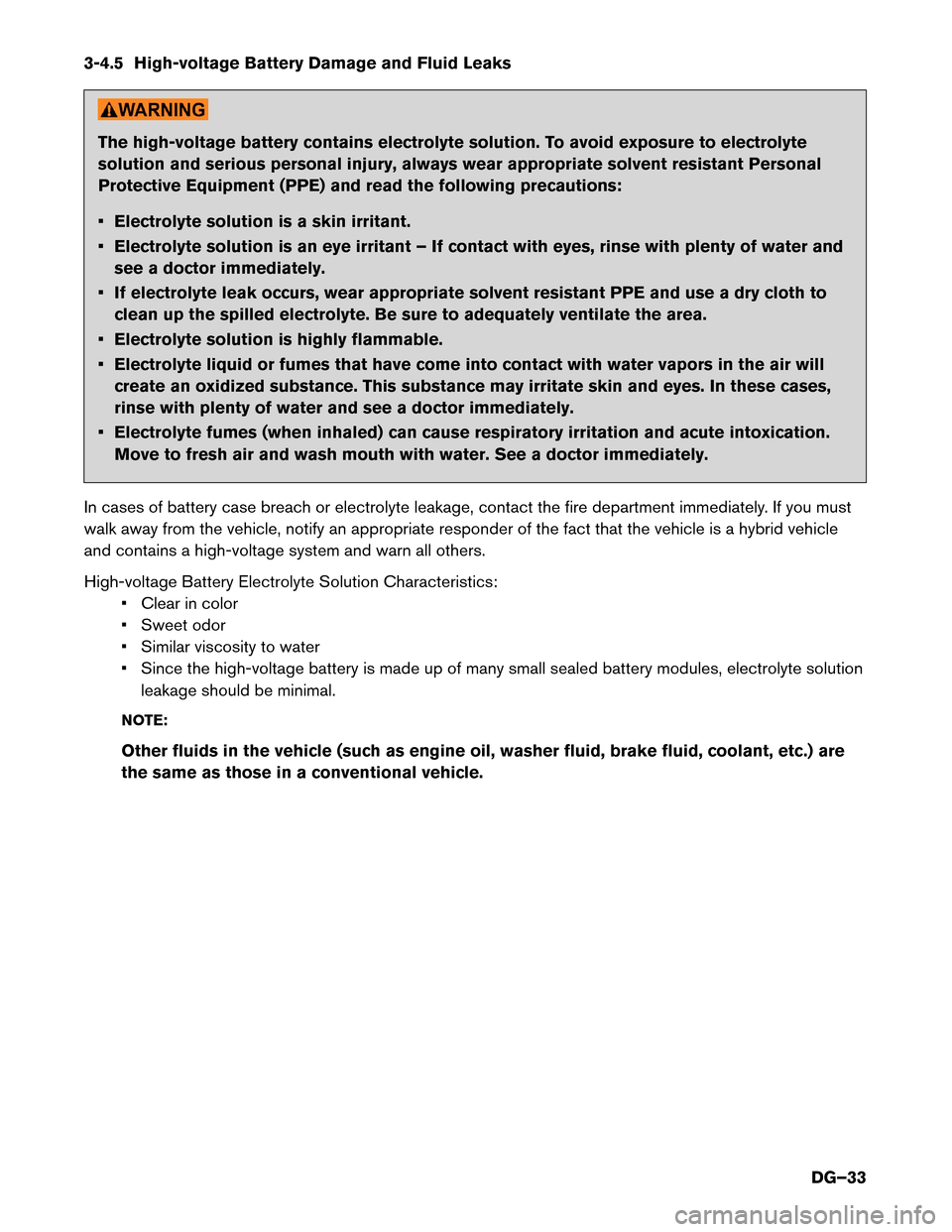
3-4.5 High-voltage Battery Damage and Fluid Leaks
The high-voltage battery contains electrolyte solution. To avoid exposure to electrolyte
solution
and serious personal injury, always wear appropriate solvent resistant Personal
Protective Equipment (PPE) and read the following precautions:
• Electrolyte solution is a skin irritant.
• Electrolyte solution is an eye irritant – If contact with eyes, rinse with plenty of water and see a doctor immediately.
• If electrolyte leak occurs, wear appropriate solvent resistant PPE and use a dry cloth to clean up the spilled electrolyte. Be sure to adequately ventilate the area.
• Electrolyte solution is highly flammable.
• Electrolyte liquid or fumes that have come into contact with water vapors in the air will create an oxidized substance. This substance may irritate skin and eyes. In these cases,
rinse with plenty of water and see a doctor immediately.
• Electrolyte fumes (when inhaled) can cause respiratory irritation and acute intoxication. Move to fresh air and wash mouth with water. See a doctor immediately.
In cases of battery case breach or electrolyte leakage, contact the fire department immediately. If you must
walk away from the vehicle, notify an appropriate responder of the fact that the vehicle is a hybrid vehicle
and contains a high-voltage system and warn all others.
High-voltage Battery Electrolyte Solution Characteristics: • Clear in color
• Sweet odor
• Similar viscosity to water
• Since the high-voltage battery is made up of many small sealed battery modules, electrolyte solutionleakage should be minimal.
NOTE:
Other fluids in the vehicle (such as engine oil, washer fluid, brake fluid, coolant, etc.) are
the same as those in a conventional vehicle.
DG–33
Page 35 of 49
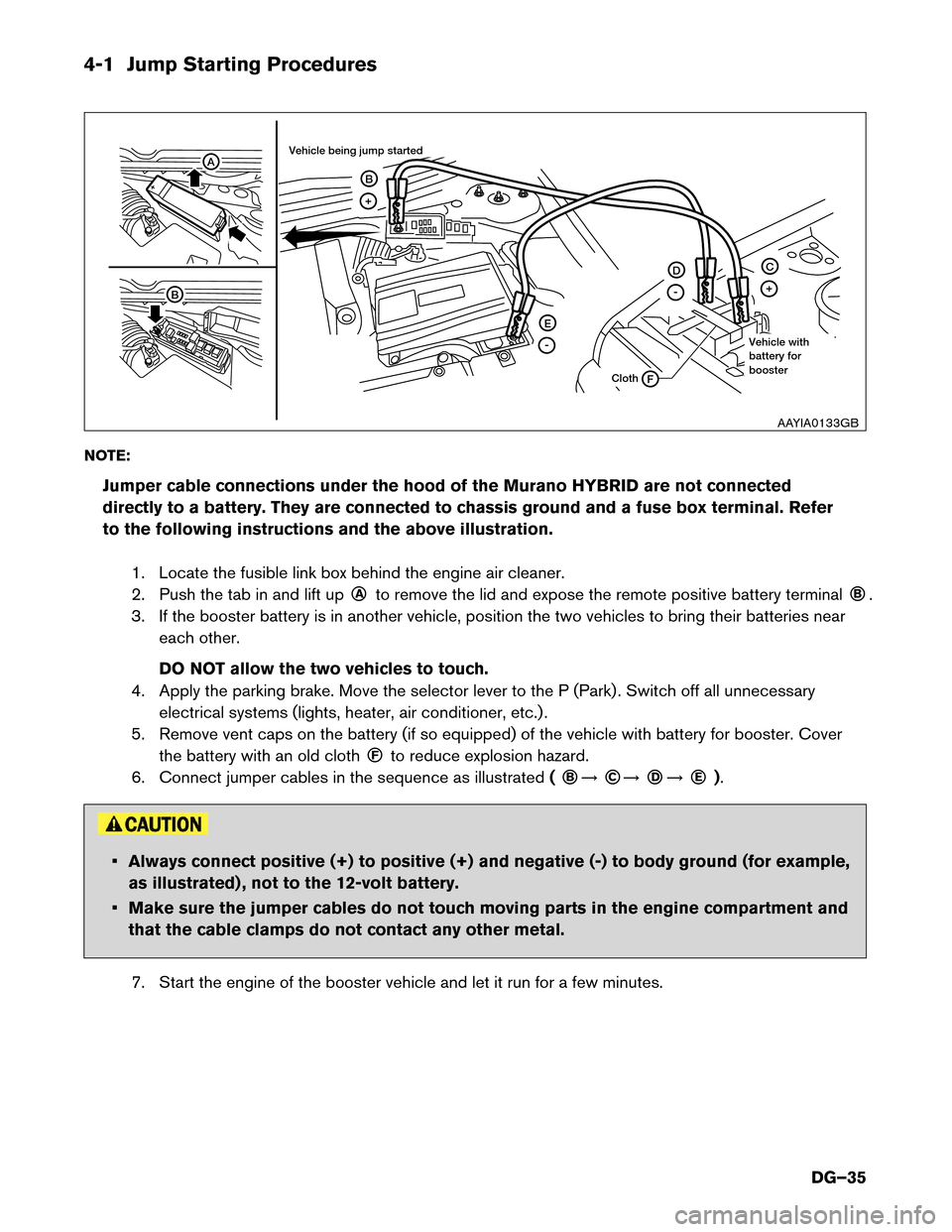
4-1 Jump Starting Procedures
NO
TE:
Jumper cable connections under the hood of the Murano HYBRID are not connected
directly to a battery. They are connected to chassis ground and a fuse box terminal. Refer
to the following instructions and the above illustration.
1. Locate the fusible link box behind the engine air cleaner.
2. Push the tab in and lift up ○A
to remove the lid and expose the remote positive battery terminal
○B
.
3. If the booster battery is in another vehicle, position the two vehicles to bring their batteries near each other.
DO NOT allow the two vehicles to touch.
4. Apply the parking brake. Move the selector lever to the P (Park) . Switch off all unnecessary electrical systems (lights, heater, air conditioner, etc.) .
5. Remove vent caps on the battery (if so equipped) of the vehicle with battery for booster. Cover the battery with an old cloth ○F
to reduce explosion hazard.
6. Connect jumper cables in the sequence as illustrated (
○B
�
○C
�
○D
�
○E
). • Always connect positive (+) to positive (+) and negative (-) to body ground (for example,
as
illustrated) , not to the 12-volt battery.
• Make sure the jumper cables do not touch moving parts in the engine compartment and that the cable clamps do not contact any other metal.
7. Start the engine of the booster vehicle and let it run for a few minutes. A
B
+
E
F
-
D
-
C
+
B
Cloth
Vehicle being jump started
Vehicle with
battery for
boosterAAYIA0133GB
DG–35